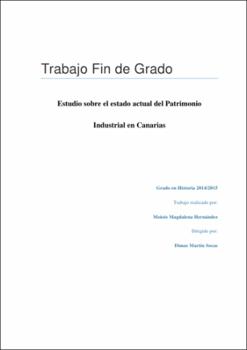Estado sobre el estado actual del Patrimonio Industrial en Canarias
Author
Magdalena Hernández. MoisésDate
2015Abstract
En los últimos cincuenta años, se ha desarrollado un nuevo concepto en el marco de la defensa
del Patrimonio, ligado a la conservación de los restos vinculados con la industrialización, es
decir, de los restos materiales más representativos de la historia universal de los dos últimos
siglos. El reconocimiento que ha tenido a nivel internacional, siendo valorado con la misma
magnitud que otros tipos de patrimonio, ha hecho de antiguos espacios industriales focos de
tracción cultural de primer orden.
Esta realidad no ha tenido eco en Canarias, donde es un tipo de Patrimonio que no se ha
contemplado desde las instancias responsables de velar por su defensa, hasta el punto que
todavía no cuenta con una figura legal en el ordenamiento jurídico. Esta imagen que se ha
trasladado a la sociedad civil no ha hecho impedir que una parte importante de las acciones de
protección esté siendo abordada desde la iniciativa particular.
Por tanto, se impone revertir esta situación, para ello la arqueología industrial ofrece la
sistemática adecuada para su rehabilitación y puesta en uso público, entendiéndolo en un
binomio claro, donde al proceso identitario, se ha de unir el de la explotación como recurso
turístico y cultural, que es el caso aquí analizado. In the last fifty years, a new concept in the context of the defense of heritage has been
developed and linked to the preservation of industrialization remains, that is, of the most
representative material remains of the universal history of the last two centuries. The
recognition that has taken internationally, being valued to the same scale as other types of
assets, has made that ancient industrial spaces become cultural centres of attaction.
This reality has not been echoed in the Canaries, where it is a kind of heritage that has not been
seen from the bodies responsible for ensuring their defense. In fact, Canary Islands that do not
yet have a legal figure in the legal system. This image, which has been transferred to the civil
society, has not avoided that significant part of the actions of protection is being tackled from
private initiative.
Therefore, it is imperative to reverse this situation. The industrial archeology provides an
accurate system for rehabilitation and commissioning public use, understanding in a clear
binomial, where the identity process has to be joined to the tourism resource and culture, which
is the case here analyzed.




